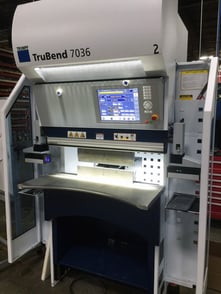Choosing between press braking and roll forming is a big decision with many factors to consider. The fabrication method you select usually comes down what method will provide you with a quality result for the lowest possible cost.
 We'll provide you with some details about press braking and roll forming and review some aspects you should consider before you decide on a sheet metal fabrication method.
We'll provide you with some details about press braking and roll forming and review some aspects you should consider before you decide on a sheet metal fabrication method.
What Is Press Braking?
Press braking, or brake forming, is a metal deformation process that aligns a piece of sheet or plate metal along an axis. This is achieved by using a machine pressing tool (press brake) to clamp the metal piece between a punch and a die set for prearranged bending.
Press braking ensures a highly precise metal bend for several types of parts. The press braking process makes a variety of shapes, some of the most common shapes being a 90° rib form, V bottom, channel, closing, double form, hat channel, offset, open hat channel, and others.
Some press brake types include:
- Mechanical press brake: Designed to convert circular motion into linear motion.
- Pneumatic press brake: Uses air pressure to move the ram.
- Hydraulic press brake: Uses hydraulic oil and a hydraulic pump as a power source.
- Servo-electric press brake: Uses a servo-motor that forces the ram to move vertically.
Marlin Steel uses the Trumpf TruBend 5230 Hydraulic Press Brake to produce more precise bends in sheet metal faster.
What Is Roll Forming?
Roll forming is a type of metal bending that involves continuous rolling of long strips of sheet metal to bend it into a desired cross section. The strip of sheet metal passes through a set of rolls typically mounted on two stands.
Each set of rolls performs an incremental part of the bend until the ideal profile is achieved.
Roll forming is a simple process that can produce complex shapes. It is often a cost-effective and responsive alternative for press braking and stamping.
Types of roll forming machines include:
- Single duty roll forming machines: Uses strategically positioned rolls to work on a specific cross-section of the profile connected to each spindle.
- Standardized rolling machines: Uses outbound supports that are easily accessible to operators. The spindle can easily be removed.
- Side-by-side machines: They accommodate multiple profiles that contain various rolling tools.
- Double headed machines: Contains two separate sets of rolling shafts and housings.
- Rafted machines: Has housings and spindle shafts with common rolling tools mounted on them.
4 Factors to Consider When Choosing a Fabrication Method
Here are four things to consider before choosing between press braking and roll forming.
1. Length
The length of your parts is essential to the fabrication method you choose.
Longer parts are best used with roll forming over press braking. This is because press braking cannot handle the manufacturing of longer parts.
Press braking material has to be split, sheeted, and cut to length before they can be entered into the press brake. Long parts such as slit coil can be added directly into the roll forming line.
2. Metal Fabrication Design
Consider your fabrication design and the shapes you'll need before you choose a fabrication method. Press braking and roll forming follow different processes, and each process has varying lengths of time depending on the complexity of the shapes you're bending.
For instance, press braking can only handle a certain amount of bends, and each one requires a separate hit. But roll forming can form complex linear shapes in one pass, which reduces production time and costs.
3. Material Selection
Some fabrication processes do better with specific materials. The material you select can make the best of your fabrication process and may even save you money.
Press braking and roll forming can form lighter materials such as flat-rolled steel or high-strength low-alloy steel (HSLA). High-strength material is difficult to press brake and roll form.
4. Tooling Costs
Tooling costs are often the same between press braking and roll forming. The price typically depends on the type of project you are doing.
Generally, the larger the volume you use with roll forming, the tooling costs are less expensive for each piece. If the volume is small, then press brake tooling is likely the most cost-effective option.
How Marlin Steel Fulfills Your Custom Sheet Metal Fabrication Needs
Marlin's degreed engineers help you to achieve the best quality for your custom sheet metal forms by using the TruBend 5230. The TruBend press brake gives them the power to manufacture at quick speeds with the highest precision possible.
Talk to Marlin's degreed engineers to get suggestions for your sheet metal application needs. From design and materials to coatings and more, Marlin has the answer to your custom metal sheet forming inquiries.
Get the best return on your investment by contacting Marlin's expert engineers today!



.gif)


